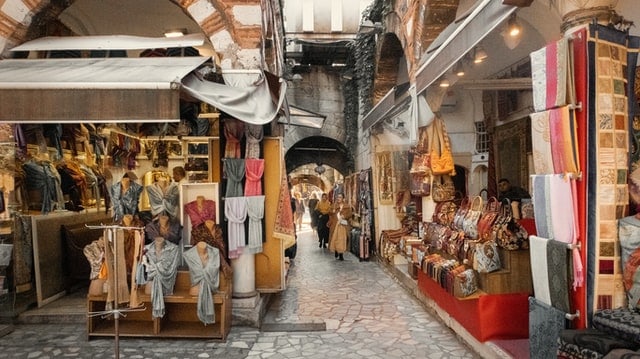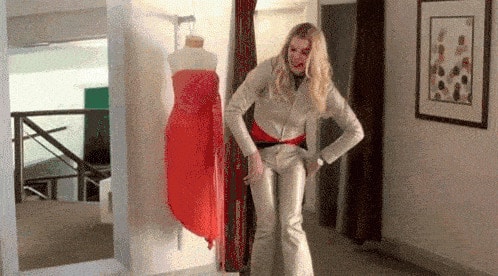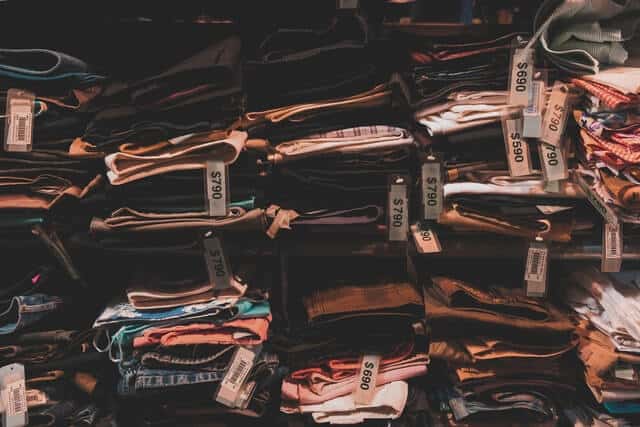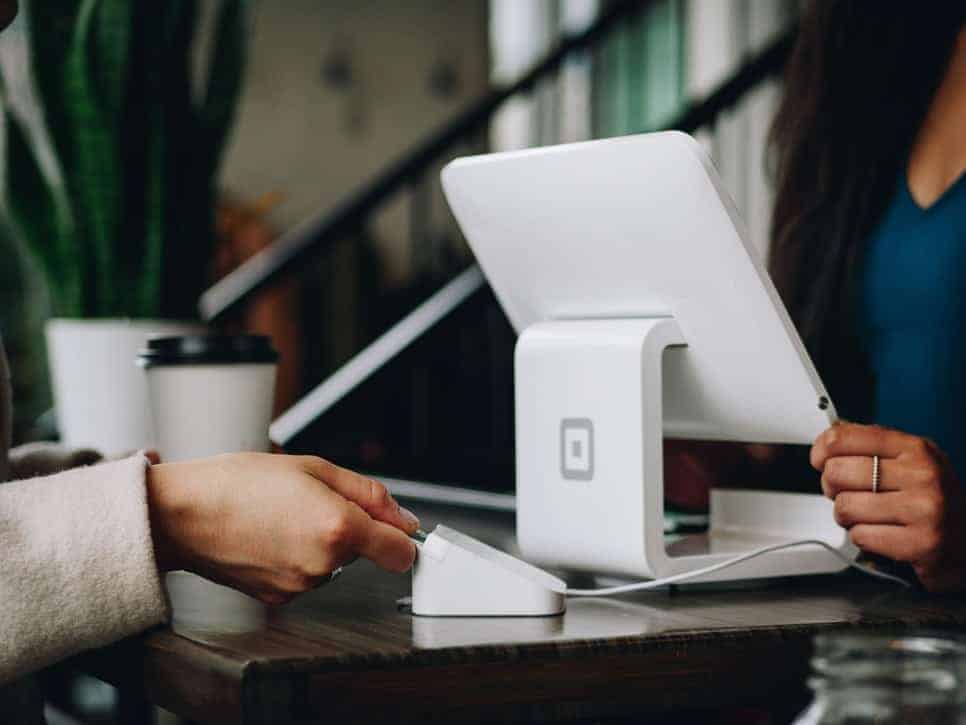How Do You Say To Buy In Spanish
If you are learning Castilian or y'all're just on vacation in ane Spanish speaking country, it's very likely that at some point y'all would demand to buy something – exist it a snack or a souvenir. In regards to the production they want to purchase, some new-Spanish speakers have issues explaining what they are looking for. After all, when shopping, almost of the fourth dimension y'all need to depict and inquire or reply many questions in order to get exactly what you are looking for, which isn't easy if you are not using your own language.
In this article, we are going to hash out how to buy something and shop in Spanish. We'll provide you with useful phrases and vocabulary so you can shop in different types of businesses. Past the end, hopefully you would feel more confident when you find yourself in this type of chat or situation.
Interacting with the Seller: The Questions They May Enquire Yous
One thing yous demand to keep in mind when ownership is that the phrases and expressions you utilize volition vary depending on where you lot go shopping. Although you accept the same purpose, going to a huge supermarket is non the same equally going to a street marketplace where the sellers take more opportunities to interact with the customers. So let's run into some of the most common phrases you may hear on street markets and minor businesses.
¿Buscaba algo en especial? – Are yous looking for something special?
This phrase is very common in modest businesses and street vendors and is the straight translation for 'Are you lot looking for something special?'. Only as in English, you may hear this phrase when buying clothes or souvenirs.
| Spanish | English |
| El vendedor: Buenos días, ¿buscaba algo en especial? | The seller: Hi, are you looking for something special? |
| Tú: No, gracias. Sólo estoy mirando. | Y'all: No, thank you. I'k only looking. |
¿Qué va a llevar? – How can I help you?

This Spanish phrase is commonly used in street and flea markets as well as corner stores. The direct translation of this phrase is 'What are you going to buy?'. Fifty-fifty though this question may be considered rude in English, in Spanish it's very mutual when shopping. If you wanted to translate '¿Qué va a llevar?' into English language, the closest phrase would exist 'How tin can I help you?'. But keep in mind that when saying '¿Qué va a llevar?' the clerk really wants to know what product you are looking to purchase.
| Spanish | English |
| El dependiente: Buenos días, ¿qué va a llevar? | The Clerk: Good morning. How can I aid yous? |
| Tú: Buenos días, dos litros de leche por favor. | You: Good morning, I want 2 liters of milk. |
Since this question is very direct, you can answer by proverb the name of the product you are looking for. Keep in mind that if you hear '¿Qué va a llevar?' in a street market it could mean two things:
- Simply as the corner store, they are request y'all what product you desire to buy.
- It can be an invitation to get closer to their stand up so you lot can meet their products and they tin start the sale.
¿Qué le voy/vamos a dar? – How can I help you?
This is some other informal phrase for 'How can I aid you lot?'. It's very like to '¿Qué va a llevar?' in the sense that the seller wants to know what product you are looking for. Information technology'due south very common in flea markets or small stores. Only as '¿Qué va a llevar?', you answer this question by maxim the name of the product y'all desire..
| Spanish | English |
| El dependiente: Buenos días, ¿qué le voy a dar? | The Clerk: Good morn. How can I assist y'all? |
| Tú: Buenos días, united nations kilo de manzanas, por favor. | You: Practiced forenoon, I want i kilo of apples, delight. |
When selling in Spanish, information technology's very common that the sellers or clerks conjugate the verbs in the plural course when talking to their clients. This doesn't mean that they are talking to a huge number of customers, it's just a casual way to speak Spanish.
| Spanish | English |
| El dependiente: Buenos días, ¿qué le vamos a dar? | The Clerk: Good morning time. How can we help you? |
| Tú: Buenos días, united nations kilo de manzanas, por favor. | Yous: Good morning, I want 1 kilo of apples, please. |
Describing What You lot are Looking For
Unless you ever become to a store where you tin can find the things you want to buy on your own, yous'll need to be able to communicate with the clerk or the shop assistant to enquire them for help. Buying in Spanish could exist a lot easier if you lot knew how to describe the things you want to get. Furthermore, it is likewise important to be able to enquire questions nearly the production's quality and characteristics. Below, you'll observe the well-nigh mutual questions and phrases you tin apply in this type of situation.
Getting What Yous Want: Asking for Characteristics
An of import role is being able to ask questions about the product's features or characteristics. As you lot can imagine, the questions you may desire to ask will vary depending on the matter you're looking to buy. However, we are going to bear witness yous some common questions you could use and nosotros are going to tell you in which situations you lot can use them.
Asking about Sizes
Although yous might think that this section is but most dress, yous take to remember that there are a lot of products y'all might exist interested in asking about the size and the color. Earlier jumping into examples, it's important to mention some vocabulary mistakes you want to avert.
While in English 'size' is used to express the dimensions of many objects such as people, clothes, shoes, and objects, in Castilian nosotros have 2 different words.
- Talla: is the Spanish word for 'size' only y'all only use information technology for clothes and shoes.
- Tamaño: likewise means 'size' just you use it to describe objects and people. Utilize this in situations where you discuss products that aren't apparel.
Here are some examples:
¿Qué talla es tu camisa? What's your t-shirt size?
¿Cuál es el tamaño de la mochila? What's the size of the haversack?
Since in English language, y'all can utilise the same word in both situations, non-Castilian speakers tend to use 'tamaño' the whole time. Although people might empathize you, it's meliorate for your Spanish if you larn the deviation and utilize the correct word. Now that you know the difference between 'talla' and 'tamaño' you lot can start request your questions.

When talking about sizes, the most common question is:
¿Qué tallas/tamaños tienes? What sizes practice you take?
Even so, if you lot are looking for a specific size, you would say:
¿Tiene + talla/tamaño + sizes?
| ¿Tiene tamaño chico? | Practise you lot accept a size minor? |
| ¿Tiene talla 38? | Practice you have a size 38? |
Or:
Quiero + este + product + en talla + sizes
Quiero estos zapatos en talla 35 I want these shoes size 35
Have Note: Notice that 'este' is a demonstrative adjective and it needs to alter to match the noun's gender and number.
Quiero esta bolsa en tamaño chico I want this pocketbook size modest
Vocabulary for describing sizes
| Actress chico | Extra-pocket-sized |
| Chico | Small |
| Mediano | Medium |
| Grande | Large |
| Extra grande | Extra big |
In Spanish, the sizes must match in gender and number with the subject. For instance:
Mi camisa es talla chica My shirt size is small
Uso calcetines actress grandes I article of clothing extra large socks
Request about Colors
Asking about your product'south color is as important every bit asking about the size. In this case, the questions are very similar to the questions related to the size. Let's see some examples.
If you just want to know virtually the different types of colors your product comes in, you would ask:
| ¿Qué colores tiene? | What colors practice yous have? |
Or:
¿Tiene en diferentes colores? Exercise you have it in different colors?
If y'all already know what color you lot are looking for, then you need to change your question a little bit:
¿Tiene en + colour + azul/rosa/morado…?
| ¿Tiene en color azul? | Practice yous have it in blueish? |
These previous examples don't mention the product considering sometimes it'southward clear for you lot and the clerk what'southward the production you lot are talking near. But if this is not the case, you could just add together it to the previous structure:
¿Tiene esta camisa en color negro? Do y'all have this t-shirt in black?
Instead of request, yous could say direct what you want:
Quiero esta chamarra en color azul I desire this jacket in blueish
Buying Co-ordinate to your Upkeep
When ownership, there volition be sometimes where either you have to stick to a budget or the store/stand has different prices for yous to choose. If this is your example, the post-obit phrases would help to purchase within your budget.
Hay desde… – The prices outset at…

Sometimes it happens that you observe a store or stand that has the aforementioned product with different characteristics and, therefore, dissimilar prices. In these cases, afterward you inquire the prices, the clerk or seller will let you know the price range by telling you lot:
Hay + desde + amount
Tengo/Tenemos + desde + corporeality
This simple phrase expresses that the prices start at a certain toll and it'due south up to you to choose the best option.
| Spanish | English |
| Tú: ¿Qué precio tienen las bolsas? | Y'all: How much are the purses? |
| Vendedor: Hay desde 200 pesos. | Clerk: They start at 200 pesos. |
| Tú: ¿Qué precio tienen los llaveros? | You: How much are the key-rings? |
| Vendedor: Tengo desde 20 pesos. | Clerk: They kickoff at 20 pesos. |
Information technology could also happen that you see the prices in a sign, in that instance, you would come across something like:
Precios desde + amount
| Precios desde 150 pesos | Prices start from 150 pesos |
The Clerk Asks Yous Nearly Your Budget
If the store has dissimilar prices, it's besides very likely that instead of giving yous the price range, the clerk will inquire you nearly the amount of money you are willing to spend. The following phrases are the Spanish grade for 'Do you accept a budget in listen?' or 'What's your budget?':
- ¿Buscaba algún precio en especial?
- ¿De cuánto es su presupuesto?
- ¿Tiene algún precio en mente?
In this example, yous could simply answer by saying the specific amount you want to spend or y'all could give them a range:
| Entre 250 y 1000 pesos | Between 250 and 1000 pesos |
Y'all could likewise say what'south your limit:
Máximo 1000 pesos one thousand pesos, tops
Que no pase de m pesos No more than 1000 pesos
Buying in a Supermarket or a Store: Asking for Help

In the previous sections, we saw some expressions and questions that will help you to describe the product you are looking for. However, at that place will be times when y'all don't collaborate all the time with a clerk. Although this happens a lot when buying in a supermarket or a big store, it doesn't mean that you may not talk at all. Unless y'all want to walk effectually the store until you observe your product, you lot demand to be able to inquire for some instructions.
The following are some questions you could ask in this blazon of situations:
Asking if they sell a product:
¿Tiene/Vende + product?
Disculpe, ¿vende mermelada? Excuse me, do you take jam?
Disculpe, ¿tienen leche deslactosada? Excuse me, do you have lactose-gratuitous milk?
Asking where you lot can find your product:
Although some people may call back that walking effectually the aisles can be very relaxing, the truth is that nearly of the time yous but want to buy what you lot need. But if you are in a supermarket or a store that you don't know, you lot may take issues finding what you want. If for some reason you are in this situation, hither are some Castilian questions you tin enquire to get help.
¿Dónde están + plural production?
Disculpe, ¿dónde está los lácteos? Excuse me, where are the dairy products?
Or if yous want to exist more polite:
¿Dónde puedo encontrar + plural product?
Disculpe, ¿dónde puedo encontrar los lácteos? Alibi me, where tin I discover the dairy products?
Take Note: When request nigh a product, we use the plural form considering it'southward more general. If you used the singular form, yous would be asking for a specific make.
Time to Pay up: Request for Prices and More
This guide on how to buy and shop in Spanish wouldn't exist complete if we didn't talk nigh paying and asking for the prices. Allow's star for the first: asking the toll.
When learning Castilian, some new speakers tend to mix '¿Cuánto cuesta?' and '¿Cuánto es?'. Although these two expressions tin be translated into 'How much is information technology?' , we don't employ them interchangeably. We'll run into how to employ both below.
Inquire for the price of 1 or multiple products:
When y'all are request for the prices, you lot would use the following construction.
¿Cuánto cuesta + singular production?
| ¿Cuánto cuesta la leche? | How much is the milk? |
Make sure the verb matches the number of products you are asking for:
¿Cuánto cuestan + plural product?
¿Cuánto cuestan los chocolates? How much are the chocolates?
Ask for the full cost:
In one case you have gathered all the products y'all desire to purchase and you are ready to pay, then you would inquire:
| ¿Cuánto es? | How much is it in total? |
| ¿Cuánto va a ser? | How much volition information technology be? |
Practise you have credit cards?
It would exist really bad to get through all the process of asking and describing your product, just to give the clerk your credit card and find out that they don't accept this form of payment. To make sure you lot're able to pay for your order, y'all could ask:
¿Qué formas de pago acepta? What forms of payment do you accept?
Or:
¿Acepta efectivo/tarjeta de crédito? Do you accept cash/credit card?

Useful Phrases and Vocabulary to Shopping in Spanish
Although in this article we tried to encompass as much as possible on how to buy in Spanish, it wouldn't exist complete without some boosted vocabulary and useful phrases.
- ¿Puedes mostrarme esa/ese…? → 'Tin you lot bear witness me that…?'. Remember to alter esa/ese to make them match with the noun.
- ¿Tiene cambio? → 'Practice you lot take change?'. Both you lot and the clerk can ask this.
- ¿Tiene united nations billete más chico? → 'Do yous accept a smaller bill?'. This question is very common when buying in smaller businesses or stands.
- ¿Quiere una bolsa? → Practice you want a bag?
- Sin bolsa → Without bag.
- ¿Me lo puedo probar? → 'Can I endeavour it on?'.
- Me queda muy grande/chico → 'It's too big/small on me'.
- ¿Puedes mostrarme otra talla?/tamaño? → 'Tin can you show me another size?'.
- Me queda muy grande → It's likewise loose.
- Me queda apretado → It'due south likewise tight.
- No me queda bien → It doesn't fit me well.
- ¿A qué hora cierra? → What time do yous close?
- Solo estoy viendo, gracias → 'I'm but looking, thanks'. This is a perfect answer when the clerk/store assistant asks you '¿Qué va a llevar' or '¿Buscaba algo en especial?'.
Wrapping Upwards
In this article, we discussed some different questions and expressions you can utilise depending on the identify you lot are shopping in. Y'all too learned some common phrases to describe what you desire or to ask for help. At present that y'all know how to buy in Spanish information technology'southward fourth dimension for you to start applying these expressions.
Source: https://www.tellmeinspanish.com/grammar/how-to-buy-in-spanish/

0 Response to "How Do You Say To Buy In Spanish"
Post a Comment